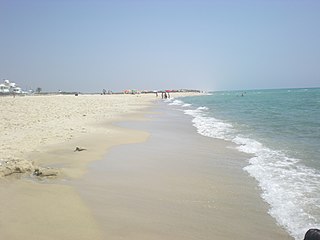Related Research Articles
Parthenia was a Roman–Berber town in the former Roman province of Mauretania Sitifensis, the easternmost part of ancient Mauretania. It was located in what is now northern Algeria.

Abitinae was a town in the Roman province of Africa Proconsularis and is famed for the Martyrs of Abitinae.

Korba, ancient Curubis, is a town in Tunisia on the eastern shore of the Cap Bon. It was the place of exile of the Carthaginian bishop Cyprian in the year leading up to his martyrdom. Modern Korba is in the Nabeul Governorate and had a population of 48,314 in 2014.
Musti in Numidia, also called Musti Numidiae, was an ancient city and bishop jurisdiction (bishopric), and is presently a Catholic titular see,(bishop's government see of a former government under a church's responsibility, also known as a dead diocese.) in modern Algeria.

Simminensis is an ancient and titular episcopal see of the Roman province of Africa Proconsularis in modern Tunisia, and a suffragan diocese of the Archdiocese of Carthage.

Unizibira was an ancient town and bishopric in Roman North Africa which remains a Latin Catholic titular see.

Thagamuta was a Roman–Berber city in the province of Byzacena. The location of the town is not definitively known, but it was on the plain of Guemouda in modern Tunisia.

Thenae or Thenai, also written Thaena and Thaenae, was a Carthaginian and Roman town located in or near Thyna, now a suburb of Sfax on the Mediterranean coast of southeastern Tunisia.

Tiguala was an ancient Roman-Berber city in the province of Byzacena. The exact location of the town remains unknown for certain, but it was in Sahel in northern Tunisia.
Tagarata was a Roman era civitas of the Roman province of Africa Proconsularis. The ancient city has been tentatively identified with ruins at Bir-El-Djedidi, Tunisia.

Utimmira was an ancient Roman town of the Roman province of Africa Proconsularis. The town was somewhere near Carthage in today's Tunisia, but the exact location has been lost to history.

Culusi was a Roman town of the Roman province of Africa Proconsolare, located near Carthage. It is also known as Culcitana or Culsitana. The city is tentatively identified with ruins in the suburbs of Tunisia.

Migirpa was an ancient Roman-Berber civitas in the province of Africa Proconsularis. It flourished from 30 BCE to 640 CE. The town is identified as stone ruins near Carthage, Tunisia.

The Diocese of Bennefa is a home suppressed and titular see of the Roman Catholic Church. Bennefa, identifiable with Oglet-Khefifa in modern Tunisia, is an ancient civitas of the Roman province of Byzacena. and a seat of an ancient Christian episcopal see. The diocese was mentioned by Augustine of Hippo.
The Diocese of Manaccenser is a suppressed and titular see of the Roman Catholic Church.

The Diocese of Pudentiana is a suppressed and titular see of the Roman Catholic Church. It was centered on the Roman town of Pudentiana that flourished in the province of Numidia, Roman North Africa, through the Vandal Kingdom and Roman Empire of late antiquity.
The diocese of Garba is a suppressed and titular see of the Roman Catholic Church.

Tambeae was a Roman civitas located in the province of Byzacena in Africa Proconsulare. It existed from the Roman era into late antiquity.
The Diocese of Torreblanda was a Roman Catholic diocese in ancient Byzacena.
The Diocese of Vittoriana is a suppressed and titular see of the Roman Catholic Church.
References
- ↑ Pius Bonifacius Gams, Series Episcoporum Ecclesiae Catholicae, (Leipzig, 1931), p. 469
- ↑ Stefano Antonio Morcelli, Africa Christiana, Volume I, (Brescia, 1816), p. 313.
- ↑ J. Mesnage, L'Afrique chrétienne, (Paris, 1912), pp. 31-32.